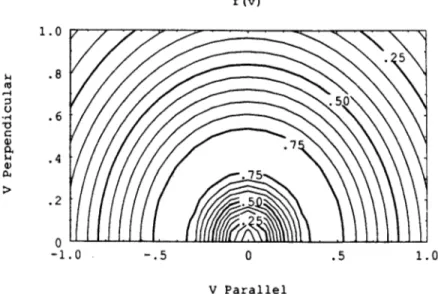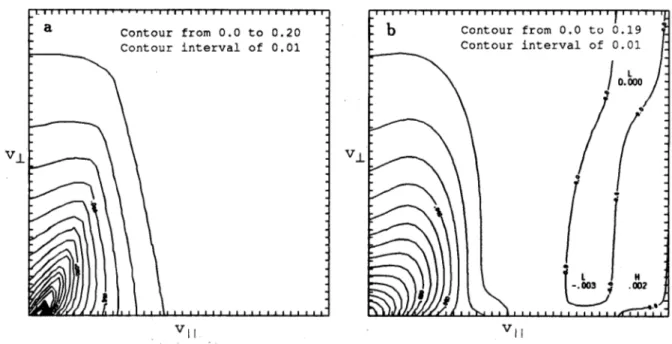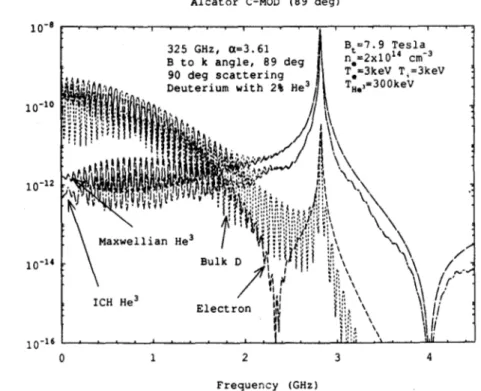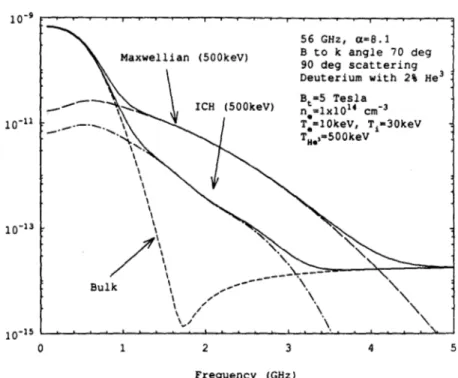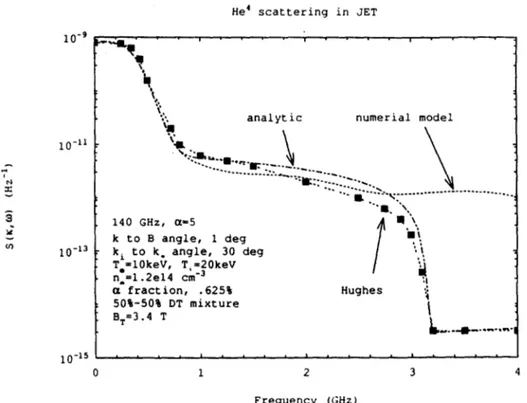PFC/JA-90-19
Calculated Collective Thomson Scattered
Spectra from Energetic Ions in Tokamaks
D. Y. Rhee, J. S. Machuzak, P. P. Woskov, D. R. CohnPlasma Fusion Center, Massachusetts Institute of Technology R. C. Myer
Aplied Science and Technology, Inc. December 31, 1990
Calculated Collective Thomson Scattered
Spectra from Energetic Ions in Tokamaks
*
D. Y. Rhee
J. S. Machuzak
D. R. Cohn
P. P. Woskov
Massachusetts Institute of Technology
Plasma Fusion Center
R. C. Myer
Applied Science and Technology, Inc.
December 31, 1990
Abstract
A new numerical code that calculates the collective Thomson scattered
spec-trum with a completely arbitrary distribution function was developed to model scattered spectra in ICRF heated and DT burning plasmas. Theoretical scat-tered spectra from energetic ions in tokamak plasmas (TFTR, JET, and Alcator C-Mod) are calculated. Calculated spectra for non-thermal minority He ions in ICRF heated plasmas along with results from Maxwellian distributions are shown. Also preliminary results of calculated spectra for alpha-particles with slowing down distribution are presented.
This work supported by DoE contract No. DEAC0278ET51013. 1
Contents
1 Introduction 4
2 S(k,w) in terms of expanded f(v) 4
3 Subtracted Maxwellian Distribution 7
4 ICH Velocity Distribution 10
5 a-particle 'Slowing Down' Distribution 15
6 Conclusion 16
Appendix: Derivation of S(k, w) with Fitted f(v) 19
List of Figures
1 Contour plot of subtracted Maxwellian f(v) with -y = 0.9, A = 0.5, and
I = 0.5. . . . . 8
2 Comparison of S(k, w) between Maxwellian and Subtracted Maxwellian distributions. . . . . 9
3 Comparison of S(k, w) between Numerical and Analytical expressions of S(k, w) for Subtracted Maxwellian distribution. . . . . 9
4 Contour plots of the 'rabbit ear' distribution . . . . 12
5 S(k, w) for Alcator C-MOD: 0 = 89.5 . . . .. 13
6 S(k,w) for Alcator C-MOD:
4
= 70.0 . . . .. 137 S(k,w) for TFTR:
4
= 70.0 . . . .. 148 S(k,Lw) for JET: 4 = 70.00 . . . . 14
9 S(k,w) for JET with a slowing down f(v): 4 = 1.00 and 0 = 30.0* . . . 17 10 S(k, w) for TFTR with a slowing down f(v):
4
= 70.00 and 0 = 90.00 . 171
Introduction
A number of high power collective Thomson scattering experiments for measurements
of confined energetic ions in tokamaks are in the planning or conceptual design stages which will depend heavily on theoretical calculations of the collective Thomson scatter-ing spectral density function, S(k, w). In the past, S(k, w) has been calculated analyt-ically for only a few velocity distribution functions, such as the Maxwellian. However, plasma physics theory predicts that present and future tokamak experiments may have ion distribution functions which will be highly non-Maxwellian and complex in nature because of ICRF and neutral beam heating, and the presence of alpha particles in D-T burning devices.
This paper will present a method to calculate S(k,w) semi-analytically for arbitrary ion velocity distribution functions using Laguerre and Hermite orthogonal polynomials.
S(k, w) using the electrostatic approximation given by Sheffield is used as starting point
of the derivation[2]. S(k,w) will be calculated for theoretically expected ICRF heating ion velocity distribution functions in TFTR, JET and Alcator C-Mod. The results are compared with an analytic model using Maxwellian ion velocity distribution functions. Also as a benchmark test, a subtracted Maxwellian distribution function which creates an inverted velocity profile in the low velocity region, is used to calculate S(k, w) and the results are compared with an existing analytic model[1]. And finally, preliminary results are presented from the study on scattering in D-T plasma by modeling the a-particle slowing down distribution.
2
S(k,
w)
in terms of expanded f(v)
The spectral density function, S(k, w), is needed in the theoretical calculation of Thom-son scattered power [2]. Calculations of theoretical scattered power and signal to noise ratio is presented in another article [3]. S(k, w) is defined as,
S(k, w) = - fe(kw) ' 2= Se + Si + i2 + ... , (1)
VT( ne
where the fluctuation wave number, k, is,
k =k - ki 1 2k, sin (0/2), (2)
and k2 is the magnitude of the incident wave and 0 is the scattering angle between ki and ks.
For a Maxwellian velocity distribution, S(k,w) is known analytically, but for more complex distributions, S(k,w) is very difficult to calculate analytically. In order to treat non-Maxwellian distributions, a general form of S(k, w) is derived by expanding the distribution function in terms of the Laguerre and Hermite polynomial series. Hence an arbitrary function composed of a series of Laguerre and Hermite polynomials can be used to fit a known form of a given particle distribution function by calculating the coefficients of the Laguerre and Hermite polynomial series. The initial distribution function can be in either analytic or numerical form. This fitted distribution function is then used to calculate S(k,w).
An arbitrary distribution function can be expressed as a sum of Laguerre, Lm(y), and Hermite, H,(x), polynomials,
f(x,y)
= Z{amnLm(y)H(x)e-YI2'e- 2/2, (3)m ti
since these polynomials satisfy orthogonality conditions[4],
Lm(y)Ln(y)e -= 6'mn, (4)
and,
,Hm(x)Hn(x)e -2 = v/2"m!bmn, (5)
where 6mn is the Kronecker delta function. Taking advantage of these orthogonality conditions, am . can be calculated,
am.= jgn(y)Lm(y)e-y/2dy, (6)
where,
w h ey g ( Y )f )= f ( X, y ) H (x ) e _ , 2 / 2 d x , ( 7 ) where f(x, y) can be any model distribution function. Maxwellian like distribution functions typically can be accurately approximated by 10 to 20 am,. coefficients. Most distribution functions modeled so far required at most a few hundred coefficients, which represents less than 100 seconds of the Cray computing time. For a Maxwellian distri-bution, only the a00 term is needed and all other higher order coefficients are zeroes.
Hence, by appropriately choosing the a00 term, the equations derived here become
exactly the equations for the Maxwellian case.
It should be pointed out that presence of sharp cutoffs in a distribution function like that of the slowing down a-particle distribution with no energies greater than the birth energy requires many am coefficients to model, and gives rise to the Gibbs phenomenon which causes erroneous results at the cutoff.
Using the arbitrary distribution function (Equation 3), a generalized form of the fully magnetized spectral density function is derived. A full derivation is presented in the appendix, and only the final result is presented here. Normalized variables are defined in the calculation of the S(k,w) with an arbitrary distribution function are as follows,
Vvvj 2v 2
_ O il __ 2 1
t= , y-I
where ol and a- = .2T Using these normalized variables and the arbitrary form of the distribution function (Equation 3), the spectral density function is,
electron term 21 H Hn(V2C) e-t S(k, o) = 7r He 2 leoi-ie(amn)e "(L(V, m) EL i m n kli(le l) ion term + r2 ZeffIHe1 Hn(v/2 I) eCI
+ 7r2ZefI 2ZZZ E o2iUI3 (amn)3 Hn(£i e (l, m), (8)
CL , i m n where, £(l, m) j'dy e y/2j 2 (OyV)Lm(y) (9) V('( M) 00 dy e-y/2jj2('3/y-)L' (y) (10) 1 n) e~2 Hn(v/t) v ; - dt (t - CO
The Gaussian quadrature integration method was used to numerically calculate the above integrals (Equations 9,10,11)[5]. The integrals of Equations 9 and 10 use 300 Laguerre quadrature points, and the integral in Equation 11 uses 80
product of modified Bessel function and an exponent, Equation 10 is zero, and Equation
11 is the plasma dispersion function.
The screening function, H3(k,w), is calculated as,
H3(k,w) = 2/ 2w, _Lm ni a2 ) n! ___n x { (, m)[2(/2)!+ Z((, n) - Z((, n - 1)] 2(n/2)! 2 2 + [((o - C)Z(C, n)( 1(l, m) - V(l, m))]}, (12) where J is the Bessel function of the first kind of order 1, and wpj is the plasma frequency of jth species. Here, the jth subscript also includes the electrons. In the derivations, the screening functions for all species, including the heavy minority ions are treated as magnetized.
With enough coefficients, the fitted function should be identical to the given input func-tion. However because of practical limitations of finite computing power, the number of coefficients are truncated at some high order. Usually the lowest order coefficient is most significant and the higher order terms become less significant. During the anal-ysis, the coefficients were truncated when the ratio of the high order coefficient to the zeroeth coefficient is less than 10'. It would be desirable to carry out the coefficients to even higher orders, but round off errors in the integration routine become too large and limit the calculation of the the coefficients to approximately 100 terms in Laguerre space. With functions that decrease very slowly or that have sharp cutoffs, higher order terms become more significant; and the coefficients decreases very slowly. Thus modeling these types of profiles are very difficult.
Coefficients decrease much more rapidly in the Hermite space; after about 20 terms, the ratio of the last term to the first term is about 10'0. Hence expansion in the Hermite space poses no numerical problems.
3
Subtracted Maxwellian Distribution
Study of scattering from the ICRF heated plasma is the main focus of this paper; however, no analytic form of S(k, w) currently exists, and no comparison can be made
f (v) 1.0 S .8 (V 7.5 .2 0 -1.0 -. 5 0 .5 1.0 V Parallel
Figure 1, Contour plot of subtracted Maxwellian f(v) with y = 0.9, A = 0.5, and
F = 0.5.
between the numerical model and analytic theory. Hence benchmark test of the new code using the new generalized form of S(k,w) was done with an existing analytic code that uses the subtracted Maxwellian distribution. This analytic code was previously used to compare with experimental data from the Tara tandem mirror device. A detailed study of scattering in tandem mirror plasma with this model velocity profile is presented by J. Machuzak [1].
The subtracted Maxwellian distribution function used here is
f(vw,vii) = 1 e-("/ I 1)e( 1 Il) -ye I -,)e- 11" 11 1. (13)
(7rueoii)3/2(l
__ yA2
F)-Parameters y, A, and F determine the depth and width of the hole in the low velocity region. To model a loss cone in a tandem mirror, approximate parameter values of -y = .9, A = .25, and F = 1 should be used. However, for benchmarking purposes, -y = .9, A = .5, and F = .5 were used to compare how effectively the fitted expansions model the given velocity distribution in both perpendicular and parallel velocity space. Ions are modeled with the subtracted Maxwellian profile, and electrons are assumed to be Maxwellian. Plasma parameters chosen model the Tara tandem mirror conditions. Figure 1 shows the contour plot of the velocity distribution. And a plot of S(k,w) spectrum is shown on Figure 2. Notice the enhanced signals in the low scattered frequency regime for the subtracted Maxwellian case in comparison to the Maxwellian case. With larger value of y (very close to 1.) the hole in velocity space becomes deeper,
and the scattered signals are even more enhanced. 8
2. 0x10' 1.5x10-7 I 1.0x10-7 0. 5x10 7 .. 0 0 Subtracted Maxwellian 7=0.9 X=0.5 F=0.5 0=45 deg 4=89.5 deg source freq. 140 GHz Maxwellian ~I II A Ii Ii II II Ig II t Ig I II A D ii ii 'I I I Ii i g Ig II I I I I' .01 .02 Frequency (GHz)
Figure 2: Comparison of S(k,w) between Maxwellian and Subtracted Maxwellian dis-tributions. 2x107 .01 7=0.9 X=0.5 r=o.5 0=45 deg 0=89.5 deg source freq. 140 GHz Analytical merical P%
~1
.02 Nu I .03 Frequency (GHz)Figure 3: Comparison of S(k, w) between Numerical and Analytical expressions of
S(k, w) for Subtracted Maxwellian distribution.
9 .03 N 5x10-8 2x10~8 10~8 5x10~9 0
" -,
I.i
-Figure 3 is a comparison of results from the subtracted Maxwellian analytic code and the numerical code using the fitted velocity profile. For this calculation, the numerical code used 60 by 10 matrix of am coefficients. Results from the two codes match very closely, and even higher degree of accuracy can be expected if the amn coefficients were carried out to higher orders. Also, when the Maxwellian velocity distribution is modeled, the numerical results match exactly with the analytical results.
4
ICH Velocity Distribution
The new code can be used to model scattering in ICRF heated plasmas. Calculations are carried out for three experimental cases corresponding to the TFTR, JET and Alcator C-Mod tokamaks. S(k,w) was calculated for 2% He' ICH distributions and plotted in Figures 6 through 8 along with 2% He3 Maxwellian calculated spectra.
The bulk ions and electrons were assumed to be Maxwellian. Near the top and bot-tom positions of the tokamak where the tip of the He' particle banana orbit is in the ICRF resonance layer, the He' distribution is believed to be approximately anisotropic Maxwellian peaked primarily in v1 space. Near the midplane of the tokamak, the ICH
distribution is believed exhibit a 'rabbit ear' feature due to conservation of energy and angular momentum as the particles travel along the banana orbit. An approximate analytic equation, describing this 'rabbit ear' distribution at the edge and anisotropic Maxwellian distribution at the banana orbit tip, is used in the calculations [6]. This equation was used to model the 'rabbit ear' ion velocity distribution to in the calcula-tion of S(k,w). To calculate the S(k,w) from a Maxwellian distribucalcula-tion, an analytic expression of S(k, w) was used in the calculations.
The ICRF heated He' distribution used is,
f(W,) = Cfjm(W)[exp( I
'
)+exp('I . )], (14) where 4(= ( V)1I
1 --i ".~i W 1- lqBmin WCmHC3 10\4A(-")(1 + (W/Wc)3/2)' Z2 Enj(Zj/Aj)1oghij (A= nlogA ' W = 1/2mHe3V2, Wc = 14.8AT{(Z), Ai A. = exp(-WTtaiI).
Here, Ttaii is the characteristic temperature of the energetic ions as described by G. Hammett[6], Bmin is the field strength at the location of scattering, 1q is the harmonic
heating number, 1L = 0.5mHe3v2 BH, BH is the field at the heating location, w is the heating frequency, A is the atomic mass number, and Aj is the Coulomb logarithm number for the j-j collision. The normalization constant, C, is determined fromr the following integral,
1 = jdWd (W,(). (15)
For the above ICH distribution function, coefficients up to m = 60 and n = 20 indices were needed to fit to the arbitrary function (see Figure 4). The values of higher order
amn coefficients decreased in magnitude very fast when compared to the a0 0 term and
required only a small number of higher order coefficients.
Calculated results of scattering from the Alcator C-Mod plasma is shown on Figures 5 and 6. Results for TFTR and JET are shown on Figures 7 and 8, respectively. Figure
5 is a case with 0, the angle between k and BT, very close to 90 degrees to resolve the
features of electrostatic ion Bernstein waves. The bulk deuterium ion feature dominates in the low end of the spectrum. The electron feature dominates in the high frequency end, as described by the first term of the Equation 8. The lower hybrid peak is evident at the high end, which is only observable for near perpendicular scattering angles to the magnetic field, as made evident by the lack of the lower hybrid feature in Figure 6 where 4 is 70". At the low frequency regime of Figure 5, enhancement of the spectrum due to ion Bernstein resonances can be observed. Note that even the He3 spectrum
exhibits resonance features (< 1.5GHz), although its contribution is negligible when compared to the bulk ion and electron features. He' feature is dominant at the mid frequency regime between 2 to 4 GHz and is enhanced by the lower hybrid feature.
" from 0.0 to 0.20 r interval of 0.01 from inter a Contou Contou
Figure 4: Contour plots of the 'rabbit ear' distribution: figure (a) is the input analytical distribution, and figure (b) is the fitted numerical distribution using m = 60 and n = 20 coefficients.
Scattering at 4 of 70' on Alcator C-Mod, TFTR and JET are shown on Figures 6,
7 and 8, respectively. A 4 of 700 was chosen to avoid the ion Bernstein and lower hybrid resonances and yet be still close to 900 to see the effect of the 'rabbit ear' distribution function. S(k, w) curves are drawn for the cases with no He3 present,
2% Maxwellian He', and 2% ICH distribution function He'. S(k,w) of ICH He3 is about an order of magnitude less in signal strength than the case with Maxwellian He3
for all three calculated cases. By examining the velocity space of the 'rabbit ear' ICH distribution function, this observation can be reconciled. At R,, the major radius of the tokamak plasma center, the ICRF is tuned to match w6, the ion cyclotron frequency, and strong perpendicular heating occurs. However, as these ions move in their banana orbits toward the outer midplane, the magnetic field is less, and v1 decreases due
to conservation of magnetic moment, and v11 increases due to conservation of energy.
Therefore, a 'rabbit ear' in velocity space occurs near the midplane of the plasma due to a depletion of high energy ions at v11 - 0. A high temperature Maxwellian distribution
would include these ions, and consequently, the scattered power would be greater for a Maxwellian distribution function since there are more ions in the v11 - 0 region of
velocity space compared to the ICH distribution function. If the scattering geometry were aligned to examine velocity space along the 'rabbit ear', then closer agreement with a Maxwellian distribution function is expected.
12 b Contour Contour VI_ VI_ 0.0 to 0.19 val of 0.01
I0.0
Li3
00?Alcator C-MOD (89 deg)
10-8
325 GHz, a=3.61 Bt=7.9 Tesla
B to k angle, 89 deg n0=2x1O'4 cm-3
90 deg scattering T,=3keV T =3keV
1 , 1 "1 Deuterium with 2% He3 TH=300keV
10-0f 10-12 - \4 Maxwellian He 10-14 Bulk D ICH He Electron 1, 10-16 ' 0 1 2 3 4 Frequency (GHz)
Figure 5: S(k,w) for Alcator C-MOD: 4= 89.5*
Alcator C-MOD (70 deg)
109
325 GHz, a=3.61
B to k angle 70 deg. Maxwellian (300KeV) 90 deg. scattering
Deuterium with 2% He3 B7.9 Tesla ICH (300KeV) 2xl0'4 cM-3 10~11 TT 3 keV TH.*3 300 key i0-13 - .-Bulk ' 10--15--0 5 10 15 Frequency (GHz)
Figure 6: S(k,w) for Alcator C-MOD: 4= 70.00
TFTR (70 deg)
10 9 . . . . '
56 GHz, a=8.1 Maxwellian (500keV) B to k angle 70 deg
90 deg scattering Deuterium with 2% He3 B =5 Tesla ICH (500keV) nt=1x10 4 cm~3 T=10keV, T1-30keV T ,,3500keV 10-Bulk 0-15 -0 1 2 3 4 5 Frequency (GHz) Figure 7: S(k,w) for TFTR:
4
= 70.0* JET (70 deg) 109 56 GHz, a=3.25 B to k angle 70 deg10-20Maxwllia He390 deg scattering
l0~10 Haxwellian Hea Deuterium with 2% He3 Bt=3.5 Tesla ICH He3 n ,14 CM-3 T,=10keV,' T =20keV IN 10---- H.'=500keV 10~ Bulk l1 0 2 4 6 8 Frequency (GHz)
Figure 8: S(k, w) for JET:
4
= 70.00The high frequency regime of the S(k, w) is affected by the bulk electron feature, and it is sensitive to the a parameter (a = 1/kAD). This parameter is 8.11 for the present scattering calculation in TFTR and 3.25 for JET. Note that the electron feature is at least one order of magnitude greater for the JET case than for the TFTR case. Although the increase in the electron feature brings up the total S(k, w), the sensitivity to the He3 feature is decreased because the total scattered spectra is dominated by the
electron feature. Hence, it is desirable to be in a regime where a is as large as possible to better resolve the He' feature.
5
a-particle 'Slowing Down' Distribution
A D-T burning plasma with fusion a-particles was modeled with the new code. As a
benchmark, a comparison was made with an existing code that analytically models the
a-particles with a slowing down distribution. Since the presence of a sharp cutoff in the distribution cannot be modeled, the slowing down distribution was modeled without the cutoff at the a birth energy. Hence the calculated scattered spectra from this model will have no roll off at the frequency corresponding to the birth energy, but the overall shape up to the cutoff should be similar to the results from the benchmark analytic model.
The slowing down velocity distribution is
0 ,V > V",
F0/(v' + v')v< ,
where F, = 3/[47rln(1 + (v./vc))], vc = 0.09o,, v. = (2E./M.)'I2 and EC = 3.5MeV. However as mentioned, the slowing down velocity distribution was modeled here with-out the birth energy cutoff in the numerical model. The benchmark analytical model uses the 1-dimensional form of the above slowing down distribution which takes the birth energy cutoff into account[7]. Calculated spectra for JET and TFTR cases are shown on Figures 9 and 10, respectively. The two models show reasonably good agree-ment, except for the absence of a roll off at 3 GHz for the numerical model. Also as a comparison, spectrum calculated by Hughes [7] is also shown on Figure 9, which closely agrees with the analytic model. Calculated results for the TFTR case is shown on Fig-ure 10. Again, except for the absence of roll off in the numerical model, the analytical
and numerical models show reasonably good agreement. A third spectrum modeling the a-particle with a 3.5 MeV Maxwellian distribution is also shown in Figure 10. Confined a-particles may have more flat, and possibly even inverted distributions [8]. With the numerical model, it is possible to model these distributions and calculate the scattered spectra. Again, the model may not give us a completely accurate results due to numerical limitations, but it may give us new semi-quantitative insights into scattering in a burning plasma. This analysis of scattering from confined alpha particles with distribution function other than the slowing down velocity distribution of Equation
5 will be performed in the future.
6
Conclusion
The calculation of the collective Thomson scattering spectral density function has been enhanced by the development of a theory which can accommodate arbitrary velocity distribution functions. Prior to this work, collective Thomson scattered spectra could be calculated for only a very few simple distributions which could be analytically solved, such as the Maxwellian distribution.
The ICH distribution function which models minority HeO ions present at the midplane of tokamak plasma was used to calculate the scattered spectra. The spectral density function with this distribution indicates a decrease of an order of magnitude in scattered power from that of a simple isotropic Maxwellian distribution function of the same temperature for the orientation of the scattering wave vector to the magnetic field considered in this report. This should improve the prospects for detecting fusion alpha particles during ICH.
The analytical form derived here is adequate for the ICH distribution function, but is inadequate, at present, for the slowing down distribution function because of the sharper cut-offs in velocity space. Numerical modeling is limited by the round off errors in the calculations of high order terms. Hence input distributions with very flat slopes or sharp cut offs that require many terms in the expansions are difficult to model adequately.
He4 scattering in JET 10' N z i 1e (J1 10-is 0
analytic numerial model
... 4. 140 GHz, (x-5 'n . Hughes k to B angle, 1 deg k to k angle, 30 deg T l10keV, T =20keV n =1.2el4 cm-3 C fraction, .625% 50%-50% DT mixture B T 3.4 T 1 2 3 4 Frequency (GHz)
Figure 9: S(k,w) for JET with a slowing down f(v): 4 = 1.00 and 0 = 30.0*
He4 scattering in TFTR 10-10-11 i 0 1 2 3 4 5 Frequency (GHz)
Figure 10: S(k, w) for TFTR with a slowing down f(v):
4=
70.0* and 9.= 90.0*17 analytic numerical model 3.5MeV Maxwellian .. ... 56 GHz, 90 deg. scat. B to k angle 70 deg. T,=10keV, Ti30keV r 50-50 DT with .625% He4 BT= 5 Tesla n =lXO14 cm-3 Sa=8.l1 10-1. 10-1 ---- - - - ----
References
[1] J.S. Machuzak Ph.D. Thesis, MIT 1990
[2] J. Sheffield, Plasma Scattering of Electromagnetic Radiation, Academic Press, New York (1975)
[3] J.S. Machuzak, D.Y. Rhee, P.P. Woskov, D.R. Cohn, R.C. Myer, Development of
High Power Millimeter and Submillimeter Wavelength Collective Thomson Scat-tering Diagnostics for Energetic Ion Measurements in Tokamaks, Rev. Sci. Instrum.
61, 3544 (1990)
[4] G. Arfken, Mathematical Methods for Physicists, 3rd Ed., Academic Press, Or-lando, FA (1985)
[5] A.H. Stroud, D. Secrest, Gaussian Quadrature Formulas, Prentice-Hall, Englewood
Cliffs, NJ (1966)
[6] G.W. Hammett, Fast Ion Studies of Ion Cyclotron Heating in the PLT Tokamak,
Ph.D. Thesis, Dept. of Astrophysical Sciences, Princeton University (1986)
[7] T.P. Hughes, S.R.P. Smith, Nuclear Fusion, 28 (1988) 1451
[8] J.G. Cordey, R.J. Goldston, D.R. Mikkelsen, Nuclear Fusion, 21 (1981) 581
Appendix: Derivation of
S(k,
w)
with Fitted f(v)
Derivation of S(k, w) along with Hj, following the electrostatic approximation as out-lined by J. Sheffield [2], is given here. H, the susceptibility for jth species is givenby
r
d 4ire2n0 __________Hj (k, w) = dv4 2 J (
- i - (16)
-o M ik2I w -- kjjvjjj- M -
i-v* is Sheffield's notation in cases where
f,,j
is independent of4.
If the velocity isseparated into v: and v11 components with respect to 4, then H can be written as 2
7rf oo w2. J1(k i)[kii + 1
Hj (k, w) = d o viLdvj do Lj kj .1 (17)
J V VJ k2 w - kili - -
i-y
Define following normalized variables and constants,
2v 1 2v
t _ , y - a2
011i L
V 2Q kjjoj'
where,o1 and ou are perpendicular and parallel thermal velocities, respectively. And, defining an arbitrary distribution function in terms of Laguerre, Lm(y), and Hermite, Ha(t), polynomials,
f(t,y) = E{amnLm(y)H(t)e-Y/2- 2 /2, (18)
m ni
and substituting it for
f,,
into the above equation,H3(k,w) = 2r k2 Jo dy- 4Jo f d- x d V12 J2 (O3 Vx)
V2k
8 4 E k- + W2 f(t, y) (19) 7rwp2,, 2 0 IWI, = 23/2k2 I _di dy E mN') 1 j x (20) m n I W- L-f
2kj1 Lm(y)e-y/2d H(t)e-t2/2 + M H.(t)e2'/2 Ld r(L-y/2dt HI 1 I a2
SH,(t))e-_2/2] ' Lm(y)e -y/2]
= [-tHa(t) + 2nH_-(t) e_ 2/2
= 1Lm(y)+ L
and redefining t' = t/Id and introducing C, then
H3(k,w) O>jo E amndt'fdyZ 2 X'
2k
2mLi n k0 -1[t
C
{ L(Y) [_2t'Ha(V/t') + 2VdnH 1(dVt')] +
i;
H(V-t') - Lm(y) + L.(y)] e-Y/2 2.Using the fact that (0 -
Cj
= and defining Amn a epeamn,k~j.,1 10,x
H11(k,w) = 27rw2 AnI jd2e3//2ete-e -y/2An-L'2' 12
L'
[t
]
(21)
2 H ,_( V t') +
(22)
[Co
- C]H.(f2t') [Lm(y) - L' (y).Rearranging the integrals in the equation,
=Am E 2 dt x
[ H( V2t') 2- H 1 (V2t')] f dye-y/ 2J(jv/y)Lm(y) + (odtH n(V-t')e _t'2
jdyJ(fjVy/) Lm(y) -LL'(y).
a dy ey/2)J,2 (# -)L.(y), Sfdy e(-y/ 2)J( 3
y)L'(y),
-
t-d'2lH(rt') 20 Using, H, (k, w) Define, (23) £(l,m) f'(l,nM) Z(Cu, n) (24) (25) (26) ' 2j L. (y) [-H,,, (,42t) 01 2 2 IliAnd using the relation, 00o t - 0
J
dt' e-*2Hn(V2t) -00 0 n odd = n n even, (M2) 27r3/2w 2 2E
A.
x a 2 , m) [ 2(n/2)! + CZ(C, n) -22 2 Z(C,n-1) + [Co - Ci]Z(, n) L(1, m) - £'(l, m))}.
With E, J?2(x) = 1 and, Ie-/2Lm(x)dx = 2(-1)', then 27r3/2w2. k2(72 IjE E
m nI A, x 0,2_Lj r q2 _(1, M) Z (Cl, n) Ili 2 - Z( ,n - 1) + [[o - LZ(, n)( L1, m) - £'(l, m))]}
Spectral density function for a two component plasma is given as:
S(k, w) = 2 lim 11- H, 12 - dv E, J?2(kp.)fo.(v)
SkO = 2f 1 (w - kilvil - 1Q,)2 + y2
+ Z IH. 12 / dv Em J,2n(kipi)foi(v)
CL H 2 1 o (w - kiivil - mf2)
2 + -y2
where EL is the dielectric function,
EL = 1 + H,(r, w) + H;(K, w). 21 and, + 0-00
C
, ' ,de-2 e - 0H.(V2t') then, (27) H3(k,w) (28) (29) H3(k, w) (30) (31) (32) (33)Using the same substitutions as Ha(k, w), then
S(k, w) = 2lim 1 - - 2,7r J0 2L dy 0 dt x j12 (p.eV-) EZy Z(a ~ Lm(y)H (t)e-y/2e-_
2/2
(amn) - -11.) 2 +
32
Noting that (w - klv 11 - = - t']2, then
S(k,) = 2lim
dt
xZ
J12(1ex.y)Z
(amn), Lm(y)Hn(t)e/e2/i mn k -C -t'] + 2
+ z - 27r f dyj -dtx
j12 (0 VY)
ZZ(amn)iLm(y)H(t)e
-y/2-t2/2m n kr
v(i
-t'] 2 + 2Hn 2 2 xr
S~~~~k,~I - w) 2rd = 2lie
+
Z!
7~eZ(a)yx-YL 6LOII m 4 f.V
jd 0 ye- ) 2J ( amny) Lm(y)
Hd,
H( 2t')e 2 (-t2)S - t' + j
Using the relation,
j12 ( -) ) (.L =, ()2
(32)
the spectral density function becomes H.2 (vI2(i) e~ M) S(k, w) = 7r2 1 -- E E(Am). "'L(lm) F-L Tn n k11,1l 7r2Z Y (Amn) Hn( ) e- L(,m). (37) fLm n I ~ o'l
With multi-ion species, the spectral density function is,
He H2 _eC2
S(k,w) = 7r2 1- (Amn) H.(V L)e (lm)
EL m n kloeg
+ 7r2Zeff E (Am)Hn(1(v ) e<f L(lm). (38)
